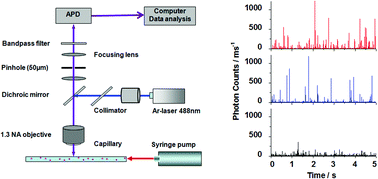Characterization of the effect of physiological cations on quantum dots by using single-particle detection
Abstract
Due to their unique physical, chemical and optical properties,

* Corresponding authors
a
Institute of Biomedical Engineering and Health Technology, Shenzhen Institutes of Advanced Technology, Chinese Academy of Sciences, Shenzhen, China
E-mail:
cy.zhang@sub.siat.ac.cn
Due to their unique physical, chemical and optical properties,

 Please wait while we load your content...
Something went wrong. Try again?
Please wait while we load your content...
Something went wrong. Try again?
C. Zhang and D. Li, Analyst, 2010, 135, 2355 DOI: 10.1039/C0AN00248H
To request permission to reproduce material from this article, please go to the Copyright Clearance Center request page.
If you are an author contributing to an RSC publication, you do not need to request permission provided correct acknowledgement is given.
If you are the author of this article, you do not need to request permission to reproduce figures and diagrams provided correct acknowledgement is given. If you want to reproduce the whole article in a third-party publication (excluding your thesis/dissertation for which permission is not required) please go to the Copyright Clearance Center request page.
Read more about how to correctly acknowledge RSC content.
 Fetching data from CrossRef.
Fetching data from CrossRef.
This may take some time to load.
Loading related content
